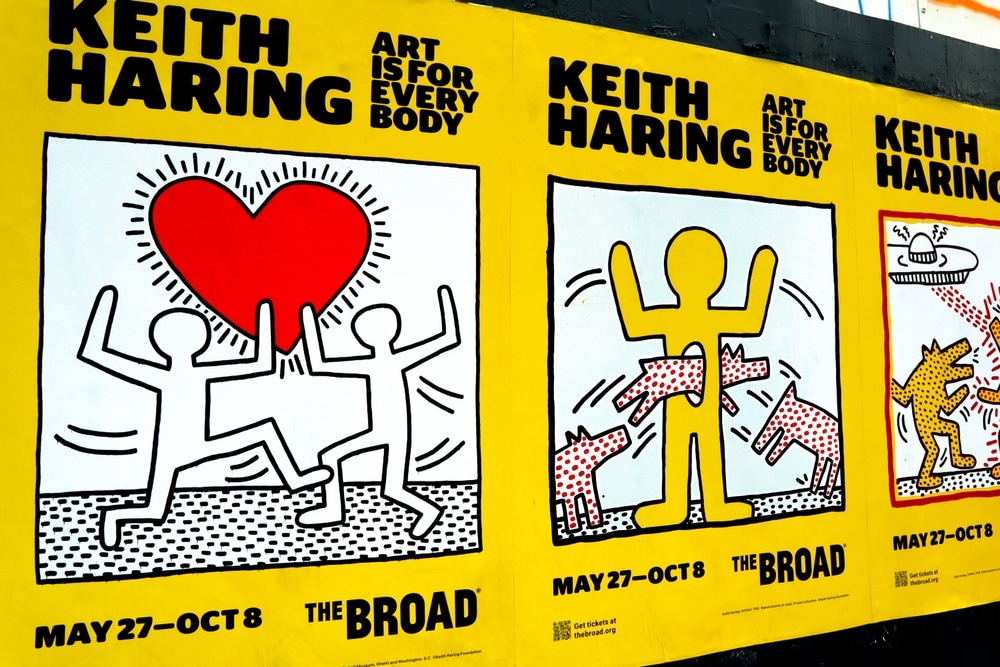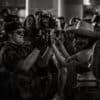In Minnesota’s Twin Cities, the name Keith Haring is hard to miss. It’s plastered on posters, bus stations, and billboards. Bright, cartoonish line drawings of people, smiling faces, and UFOs fill the ads.
The posters, put up in partnership with Twin Cities MetroTransit, advertise the Walker Art Center’s exhibit on Haring’s work and life. The exhibit, entitled Keith Haring: Art is for Everybody, runs from April 27-Sept. 8.
Haring has his well-known signature motifs, and if the name isn’t familiar, the imagery almost certainly is. Haring’s work, a staple of the pop art movement, has diffused itself broadly into contemporary culture. His work is often associated with radical love and the artistic explosion of 1980s New York. But his unwavering commitments to gay rights activism, AIDS education, and criticisms of consumerism are more often overlooked.
I saw Haring at every stop on my hour-long bus ride. I was met with smiling faces and happy dancers. Inside the Walker, a more radical side to his work is on display. The exhibit, originally shown at The Broad, covers the artist’s short but powerful career. It began in 1979 and ended in 1990, when the artist died from complications with AIDS.
The ‘Subway Drawings’
Unlike the bus stops, the first room is dark and covered in projections of line drawings done in white chalk on black paper. Haring hung them in NYC subway stations between 1980-84, employing thick, simple lines.
There’s a barking dog, a radioactive baby, UFOs, all things that would become staple images for Haring. Motion lines surround them as they shout, dance, and are afraid. Each element is collaborative, and all were photographed by Haring’s friend and artist, Tseng Kwon Chi.
A room to the side warns guests of the graphic material past the door. In an untitled tryptic from 1980, two people have sex under a ray beamed by a UFO. In one panel, a crowd reaches toward the statue of a golden calf–a biblical allusion. Then, the gesture repeats itself across the room. There, a man sticks his penis through a wall, and a crowd reaches towards it. This work is entitled Gloryhole (1980).
However playful, the paintings are not trivial. They grapple with sex, love, and Haring’s own identity as a gay man in a world that made no room for it.
Although the Walker’s exhibit largely ignores it, religion appears frequently in Haring’s work. Crosses are a common motif, sometimes impaling and oppressing, sometimes watching over love. Sometimes, they are simply there.
Haring’s work reflects the often contradictory demands society puts on the people at its margins. To love, to paint, but not like this or that. To send the point home, right next to the entryway to the exhibit, is an arrest record dated 6/27/83. It sports Haring’s fingerprints, who was charged with vandalism for the subway drawings.
Dance and the Day-Glo
Further in the gallery are the Day-Glo paintings, which are pieces from his debut show with frequent collaborator LAII (Angel Ortiz). Being first exhibited in 1982 at the Shafrazi Gallery, these mural-sized paintings were made by covering sheets of aluminum with Day-Glo, acrylic, and enamel.
The Walker also mirrors the original show by covering the room in big, bright stripes, like a circus. Gallerists, graffiti artists, and club kids are all in attendance.
The works are openly inspired by the Black and Latinx graffiti, hip-hop, and breakdancing culture that flourished in 1980s New York. Haring wanted to champion these scenes. He saw his works’ purpose in the interactions of the people viewing them and the ideas they took from them. He believed his work and collaborations could challenge racist beliefs in and out of the art world.
But despite Haring’s aims, the show launched him into attention, which Ortiz, a man of Puerto Rican descent, had never received. Although it recognizes the gray area between celebration and appropriation in which Haring worked, The Walker ignores this part of the story, largely focusing on Haring’s collaborative and social success.
Haring: a multi-media sensation
With his reputation spurred on by the Shafrazi opening, Haring became infamous for his imagery and motifs. Their constant repetition in his paintings, as well as in his collaboration with others, spread them as quickly across mediums as social circles.
Early in the exhibit is a set of televisions, all playing different video performances. One in particular, Lick Fat Boys (1979), mirrors the simple, repetitive gestures of his painting with echolalic phrases like “Fat if art. Fat art boys. Sin boy art,” changing a few words at a time before reaching “Lick fat boys,” repeated over and over. On the screen, Haring spells the words in hung-up block letters, turning the words into simple movements and gestures.
This is not the last time Haring appears in films. In Trickfilmladen, a 1984 short film made in collaboration with Swiss animators Rolf Bächler and Franz von Reding, Haring’s figures dance across the screen to a synthesizer beat. He appears, again, on video in Long Duets, a 1982 performance piece by dancer Bill T. Jones, who dances in the center of the screen as Haring paints a mural in the background. A television displays a recording from the 1984 Party of Life, the first of a legendary series of birthday parties put on by the artist. Madonna performs on screen wearing a pink leather suit designed by Haring and LA II.
Art as activism
As Haring’s gallery presence grew, so did his activism. He plied his motifs towards large initiatives like the 1985 benefit concert Live-Aid. There, he painted a mural depicting two large hands holding a heart that contains the earth. Below, a crowd of people dance.
The exhibit displays a massive, untitled piece from 1984–on it, a pig’s head. A network of teats stem from the head, which vomits out a sea of tiny green figures–people, products, and dollar signs. Desperate, grey humans clamber out of the vomit, suckling at the pig. This painting, a mockery of capitalist consumerism, was made during the Reagan presidency as the shadow of Reaganomics loomed large.
These works are obvious in their urgency. Posters that educate about HIV/AIDS cover a gallery wall. The largest, made for the New York City Department of Health, advertises a hotline for the disease. Another shows a smiling, anthropomorphic penis holding up a condom. Above it, a slogan reads, “SAFE SEX!” There is also a poster for National Coming Out Day, and below that, a poster with three figures trembling with anxiety. It reads “IGNORANCE=FEAR” and “SILENCE=DEATH.” The majority of these were made in 1988 and 1989, shortly after Haring’s own diagnosis of AIDS.
After his diagnosis, Haring founded the Keith Haring Foundation, which still exists today. It controls the licensing and propriety of his work and gives grants to non-profits for underprivileged youth and AIDS advocacy and care–by now nearly $50 million.
Pop-Shop at the exhibit
By 1984, Haring had to abandon his subway graffiti project. Collectors ripped them off the walls as soon as Haring put them up, chasing the high prices they’d fetch on the art market. Haring’s fame spelled their end.
In response, Haring opened the Pop-Shop in 1986. Based in the SoHo neighborhood of Manhattan, it sold merchandise made by Haring that sported his designs. Consequently, his gallery prominence and high price tag were subverted in one fell swoop. In addition, the ease of reproducibility of his motifs became the shop’s MO.
As an homage, the Walker painted the room with squiggly black lines like the original store. Old products sit behind glass: skateboards, pins, T-shirts, posters, and even condom carriers. The exhibit’s ideas express the following quotation: “I wanted to continue this same sort of communication as with the subway drawings.” Moreover, the quotation adds: “I wanted to attract the same wide range of people, and I wanted it to be a place where, yes, not only collectors could come, but also kids from the Bronx.”
Keith Haring, a licensed brand
To say this commercialization has carried on is an understatement. The Financial Times even asks if we’ve not had enough of Keith Haring, citing his imagery on designer clothing with price tags in the hundreds. It’s in the Walker gift shop, too, right by the exhibit. There, Keith Haring branded speakers, clothing, and skateboards stock the shelves. Any visitor can buy a neon sign of Haring’s iconic Radiant Baby–only $299.
@splendadanny kicking off Pride with Keith Haring: Art Is for Everybody @The Broad Museum!! Such a beautifully curated exhibit highlighting Keith Haring’s rise to fame and his passion for social justice pursuits in the 80’s!! Loved exploring all his different mediums and themes, focusing on issues like wh*te supremacy, AIDS, end of South African Aparth*id, & social equity in the art space! This exhibit is one for the books! So happy I got the opportunity to see one of my favorite queer artists during Pride! My heart is extra full now! 🥹💓 #art #keithharing #keithharingfoundation #thebroad #museum #la #LAart #lgbt #pride #queerart #AIDS #gay ♬ Blue Monday – New Order
However, the imagery is carefully selected. No object contains the sex or social satire found in Haring’s original work. None of the challenges, risks, and beliefs can be found in the gallery. There aren’t even condom carriers. In the end, the gifts seem to have forgotten Haring’s vision and remembered someone else’s.
We’re left with an imperfect memory of the artist. Haring’s commercial memory is him at his safest, his most palatable and consumable. Where his style has spread to new consumer corners, the impetus behind it struggles to catch up. As a result, some even argue Haring’s reputation has died.
Unfinished Painting
Although overpowering commercialization is not confined to Haring’s legacy, it also doesn’t define it.
The last room of the Walker’s exhibit, placed after the Pop Shop, is about death. Some of the works predate Haring’s AIDS diagnosis, but they all have imagery of heaven and hell. They all have something of the afterlife.
These works are, consequently, some of the largest in the whole exhibit. On one side, an untitled work from 1987 takes up the entire length of the room. On another, a phallic silhouette stretches from floor to ceiling as figures cover it. Through these figures, capitalism, religion, and violence imprison them. They sprout wings, give birth, and are erect. Atoms, guns, knives, Venus symbols, first crosses, and then crowns all fill the space between. It’s acrylic paint on canvas, 1988, entitled The Great White Way.
And then, by the doorway leading out, is Unfinished Painting. Painted in 1989, this is one of Haring’s most famous works and one of his last. His familiar dancing shapes decorate the left corner–purple, with silver highlights. Paint runs down the edge, and the rest of the canvas is blank. It’s the smallest painting in the room, but the one bearing the biggest weight of his impending death.
Haring’s imagery, motifs, community, relationships, brands, critiques, and products are in that moment interrupted. In an artist famously at once maximal, consumable, and critical, we see another side: silence.













